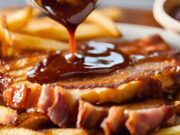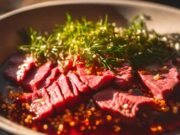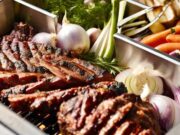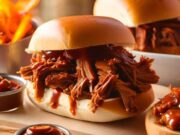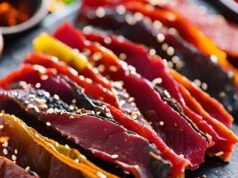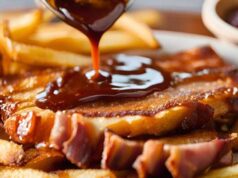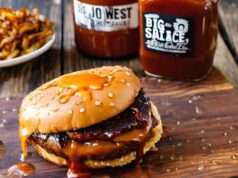When it comes to BBQ, the right steak cut can make all the difference between a good meal and a memorable feast.
This guide covers the essentials of selecting the best cuts for your grilling needs. From understanding what makes a steak great to exploring top choices like ribeye and filet mignon, there are tips on preparation, cooking techniques, and the best marinades to elevate your BBQ experience.
Get ready to impress your guests with perfectly cooked, mouthwatering steaks!
Key Takeaways:
- Choose cuts with good marbling and thickness for the best BBQ steaks.
- Consider the type of steak and its fat content when selecting the perfect cut.
- Experiment with different marinades and seasonings to enhance the flavor of your BBQ steaks.
Understanding What Makes a Great BBQ Steak Cut
To comprehend the characteristics of an exceptional BBQ steak cut, it is essential to consider key factors such as marbling, tenderness, and the overall flavor profile of the meat. An ideal BBQ steak should exhibit a harmonious balance of succulent fat and robust muscle, ensuring a delightful experience with each bite.
Cuts with high marbling tend to produce juicy and flavorful steaks that are particularly suited for grilling. Additionally, exploring the science of beef grading, including USDA ratings, can aid in selecting cuts that offer optimal flavor and texture.
The USDA grading system is instrumental in identifying superior steak cuts, categorizing them into Prime, Choice, and Select grades. Prime steaks, characterized by their abundant marbling, are typically reserved for high-end restaurants and are renowned for their exceptional taste and tenderness. Choice cuts, while exhibiting slightly less marbling, still provide a satisfying eating experience, making them a favored option for backyard BBQs.
Understanding these classifications enables grill enthusiasts to make informed decisions, ensuring the selection of cuts that not only deliver juicy bites but also cater to discerning palates. Ultimately, the relationship between marbling, USDA grade, and flavor serves as a guide to achieving grilling excellence.

How to Choose the Best Cuts for BBQ Steaks
Selecting the optimal cuts for BBQ steaks requires a careful consideration of individual preferences, budgetary constraints, and the distinct characteristics of various steak options.
Notable selections, such as ribeye, porterhouse, and T-bone, are recognized for their tenderness and robust flavor profiles. Conversely, cuts like flank and skirt steak may present a more economical alternative while still delivering on taste.
It is essential to evaluate factors such as marbling, thickness, and the intended cooking method when choosing these cuts, as these elements play a significant role in achieving the desired texture and flavor during each grilling experience.
Top BBQ Steak Cuts
In the realm of barbecue, certain cuts of steak are distinguished by their unique flavors and cooking characteristics, rendering them particularly suitable for grilling aficionados.
Among the premier BBQ steak cuts, ribeye is renowned for its abundant marbling, which contributes to its rich flavor profile. Additionally, T-bone and porterhouse steaks provide a dual offering of tender filet mignon and flavorful strip steak within a single cut.
Furthermore, strip steak, sirloin, and other notable selections such as picanha and tri-tip merit acknowledgment for their versatility and appeal on the grill.
1. Ribeye Steak
Ribeye steak is widely regarded as one of the finest cuts for barbecuing due to its exceptional marbling and rich flavor profile. The elevated fat content in ribeye not only enhances its tenderness but also creates a juicy and delectable experience when grilled to perfection. This cut is particularly favored by barbecue enthusiasts who seek a tender and flavorful steak that performs exceptionally well under high-heat cooking methods such as grilling or broiling.
What distinguishes ribeye is its marbling, characterized by intramuscular fat that melts during cooking, thereby infusing the meat with flavor and contributing to a sumptuous texture. For optimal results, employing techniques such as reverse searing or utilizing a cast-iron skillet can effectively achieve a desirable crust while preserving a pink, juicy center.
When served, ribeye pairs wonderfully with accompaniments such as garlic mashed potatoes or grilled vegetables, and a simple chimichurri sauce can enhance its flavor, maximizing the overall sensory experience during the meal.
2. T-Bone Steak
The T-bone steak is a highly esteemed selection for barbecue enthusiasts, offering an exceptional combination of a tender filet mignon on one side and a flavorful strip steak on the other. This cut is recognized for its distinctive shape and the rich flavors it imparts when grilled. When prepared correctly, the T-bone steak becomes remarkably juicy and tender, establishing itself as a preferred option for many meat connoisseurs seeking a classic barbecue experience.
Featuring its characteristic T-shaped bone, this steak not only delights the palate but also presents an impressive visual appeal. The optimal grilling technique involves lightly seasoning the steak to enhance its inherent flavor, followed by searing it over high heat to retain its juices while achieving an ideal char.
Employing a two-zone grilling method—cooking over direct heat followed by a gentle finish on indirect heat—ensures that both sides are cooked with precision. When grilled to perfection, the T-bone steak showcases delightful textures, with the contrasting tenderness of the filet mignon complementing the robustness of the strip steak, making it an outstanding choice for gatherings and special occasions.
3. Porterhouse Steak
Porterhouse steak is widely regarded as the premier cut for barbecuing, featuring both the tender filet mignon and the flavorful strip steak, separated by a T-shaped bone. This substantial cut is ideal for those who wish to enjoy the finest attributes of both cuts in a single grilling session. Given its impressive size and rich flavors, porterhouse steak is an exceptional choice for family gatherings or special occasions where grilling takes center stage.
What distinguishes this cut is its remarkable balance of tenderness and flavor intensity, which has made it a preferred option among grilling enthusiasts. Whether cooked to an impeccable medium-rare or seasoned with a carefully curated blend of spices, the porterhouse exhibits a delectable marbling that enhances its flavor when cooked over an open flame.
Suitable for both professional chefs and home barbecuers, the porterhouse steak serves as an excellent canvas for a variety of marinades and rubs, further enhancing its natural juiciness. For those seeking an extraordinary grilling experience, the porterhouse steak certainly delivers in terms of flavor, accompanied by the enticing aroma of beef sizzling on the grill, making each bite truly exceptional.
4. Filet Mignon
Filet mignon is renowned for its exceptional tenderness and rich, buttery flavor, making it a highly desirable cut of steak for barbecuing. Often considered the most luxurious cut, filet mignon is ideal for individuals seeking a truly melt-in-your-mouth experience. Its fine texture and subtle flavor profile complement a wide range of seasonings and marinades, rendering it a versatile option for grilling aficionados.
This exquisite cut is sourced from the tenderloin of the beef, ensuring that each bite delivers a sumptuous taste sensation. When grilled, filet mignon retains its remarkable juiciness, benefiting from high temperatures that seal in its natural juices while developing a delicate char.
Its versatility allows for seamless pairing with various side dishes, ranging from classic baked potatoes to gourmet salads, appealing to both traditional and contemporary tastes. For those looking to enhance the flavor, simple rubs or sauces made from fresh herbs and garlic can further amplify its naturally rich taste.
Filet mignon not only stands out due to its quality but also transforms any barbecue gathering into a fine dining experience.
5. New York Strip Steak
The New York strip steak is a highly regarded choice among barbecue enthusiasts, renowned for its robust flavor and satisfying tenderness. This particular cut is distinguished by its fine grain and generous marbling, which contribute to a juicy mouthfeel when cooked appropriately.
Ideal for high-heat grilling, the New York strip steak provides a delectable balance of flavor and texture, establishing itself as a staple at any outdoor barbecue.
Its well-defined beefy taste is complemented by a subtle sweetness that can be enhanced through the application of simple seasonings such as salt and pepper or a rich marinade. When prepared on a hot grill, the steak develops a perfect caramelized crust that effectively seals in its flavorful juices.
For culinary enthusiasts, employing techniques such as reverse searing can further enhance the dining experience by achieving optimal doneness while retaining moisture.
This cut not only satisfies those who appreciate a hearty meal but also pairs beautifully with various accompaniments, including grilled vegetables or a robust chimichurri sauce, thus making it a versatile option for a delightful dining experience.
Tips for Preparing and Cooking BBQ Steaks
Preparing and cooking barbecue steaks to an optimal standard involves a blend of techniques designed to enhance both flavor and tenderness. It is essential to begin with high-quality cuts of meat and consider methods such as marinating or dry-aging to intensify their flavor profile.
Adhering to appropriate cooking temperatures is critical, as each cut necessitates specific techniques to achieve the desired level of doneness, whether one prefers medium-rare or well-done.
Additionally, it is important to rest the steaks after cooking, allowing the juices to redistribute, which ensures a juicy and flavorful experience with every bite.
Best Marinades and Seasonings for BBQ Steaks
The most effective marinades and seasonings have the capacity to elevate BBQ steaks, enhancing their inherent flavors and tender texture. A diverse range of ingredients can be employed to craft exquisite marinades, including acidic elements such as vinegar and citrus, which assist in tenderizing the meat, as well as flavorful components like garlic, herbs, and spices.
Furthermore, dry rubs represent an excellent method for infusing flavor without the necessity of marination, thereby allowing the robust taste of the beef to be prominently featured.
Frequently Asked Questions
What are the best cuts of meat for BBQ steaks?
The best cuts for BBQ steaks are those that are tender and flavorful, such as ribeye, New York strip, and T-bone steaks.
How should I choose the right thickness for my BBQ steaks?
The ideal thickness for BBQ steaks is between 1 to 1 ½ inches. This will ensure that the steaks cook evenly and retain their juiciness.
What is the difference between marbling and fat content in steaks?
Marbling refers to the intramuscular fat found in steaks, which contributes to tenderness and flavor. Fat content, on the other hand, refers to the amount of fat present on the exterior of the steak.
Should I choose bone-in or boneless steaks?
This is a matter of personal preference. Bone-in steaks tend to have more flavor and are harder to overcook, while boneless steaks are easier to eat. It ultimately depends on your preference and cooking method.
What is the best way to cook BBQ steaks?
The best way to cook BBQ steaks is over high heat, either on a grill or in a cast iron skillet. This will create a nice sear and lock in the juices of the steak.
How can I ensure that my BBQ steaks are cooked to the right temperature?
The most accurate way to check the temperature of a steak is by using a meat thermometer. The USDA recommends cooking steaks to an internal temperature of 145°F for medium-rare, 160°F for medium, and 170°F for well-done.








